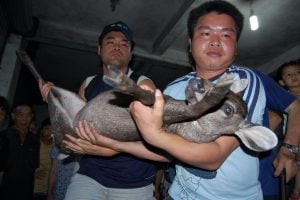China’s burgeoning environmental movement has been shaped by – and sometimes conflicted with – existing cultural mores. In this adapted excerpt from the new book China and the Environment: The Green Revolution (London and New York: Zed Books, April 2013) chinadialogue’s Olivia Boyd dissects the occasionally contentious growth of animal welfare campaigns.
Not all of China’s campaigns have taken a consensual approach. One of the arenas of Chinese activism readiest to embrace conflict is also one of its newest: the emerging field of animal welfare.
China is not a country known for its sentimental attitude towards animals. From zoo visitors paying to dangle live chickens into tiger enclosures, to doctors grinding tiger bones into a health tonic, or restaurants serving up feline platters, paws and all, Western newspapers love to recount tales of China’s callous approach to other living creatures. But that stereotype is being undermined.
Led by NGOs, or looser volunteer coalitions, and bolstered by an army of vocal citizens online, the emerging animal-welfare movement is campaigning to outlaw cruelty, from abusive farming practices to use of animals in circus performances, to drawing bile from live bears for traditional Chinese medicine. The manner in which it is panning out provides a window into the unique dynamics and conflicts of a stratified and changing China.
There are many narratives on offer. In one, animal protection campaigners are the true traditionalists, embodying Buddhist and Daoist reverence for the living world in a fight against a brutal, get-rich-quick modernity. In another, wealthy urbanites are pitted against animal traders and transporters who are simply trying to feed their families; or doctors, chefs and community leaders guarding centuries-old traditions.
Hao Xiaomao, a lorry driver barricaded by activists on an expressway near Beijing while driving 500 dogs to the slaughterhouse in spring 2011, summed up this side of the argument when he told journalists that the activists who stopped his truck ‘think dogs are more important than people’.
Dogs and cats have held centre stage. The Harbin expressway stand-off is just one of many roadside rescues to have taken place in recent years. Around 2,000 dogs are thought to have been liberated this way between 2011 and 2012 alone. But these events were not the first battles in the war on dog meat; the earliest blasts of that crusade on the Chinese mainland came from the Chinese Animal Protection Network (CAPN), launched in 2004.
Isolated animal welfare organisations were already working to rescue strays by then, but consumption of dogs and cats hadn’t made it onto their agenda. Indeed, these groups were unconvinced that stopping people from eating one or two particular species was anything but an exercise in arbitrary morality. So CAPN sought to reframe the debate as one about cruelty rather than taste. ‘We want to make more groups aware [that] reducing [the] consumer market is the fundamental solution for related cruelty issues’, the group said in a 2008 review of its work.
Supported by international groups including the RSPCA and World Society for the Protection of Animals, CAPN has worked to link animal-lovers across China and to educate the public on the facts of the trade. That many of the 10,000 cats consumed daily in winter in Guangdong province (where the meat is considered a warming food) are stolen from other provinces features heavily in the literature, for instance.
In early 2007, the group launched an online ‘signing event’ which asked people to pledge to avoid cat and dog meat in future. In the following five months, it collected 21,000 signatures. By the spring of 2008, CAPN had forty-eight member groups, two branches and more than 10,000 individual supporters.
The fight for China’s ‘companion animals’ has grown in prominence since. Before the 2008 Olympics, Beijing officials ordered dog meat off the menu at official Games restaurants. Then, in July 2010, Shanghai film-maker and animal-rights campaigner Guo Ke released a headline-hitting documentary about China’s cat-meat industry, called San Hua – or ‘Three Flowers’ – after his pet cat. Shanghai-based magazine Bund Pictorial carried a description of one of its scenes:
At Fa’s Cat Restaurant in Guangzhou’s Kaiping district, the cook throws cats – too exhausted to struggle – into an iron bucket and beats them with a wooden stick. Five minutes later, the already-stiffening cats are tipped out of the bucket into a cylindrical fur-removing machine. The machine screeches into action and shortly the bloodied corpses are removed and taken to the kitchen for boiling. The cook explains: ‘The worse you treat them the better they taste. It makes sure the blood gets into the meat and it tastes delicious’.
As awareness of these practices has grown, so has pressure on government. Perhaps the biggest victory for the activists came at the end of 2011, when officials cancelled a 600-year-old dog-meat festival in eastern China’s Zhejiang province thanks to a public outcry online.
As well as demonstrating the growing power of the animal protection lobby, the event highlighted the knottier impacts of its actions, as locals mourned the passing of an ancient tradition. A provincial government official was quoted in local media as saying ‘some villagers argued that they had emotional attachments to the festival, as it had been passed from generation to generation, while some said it should be listed as the city’s cultural heritage.’
Surging wealth and enduring poverty, modernity and tradition, xenophobia and international collaboration – these are some of the friction points of a country transforming. Some of China’s animals are now caught up in the mix.




